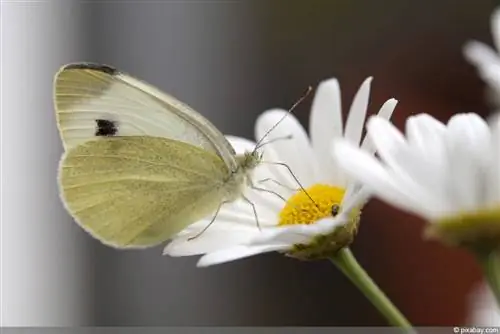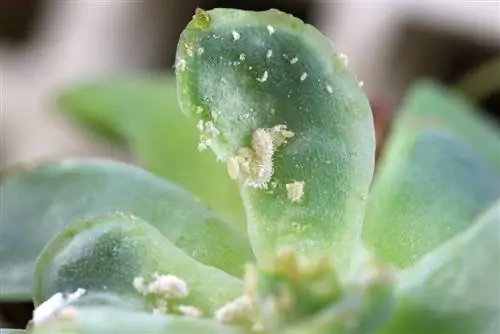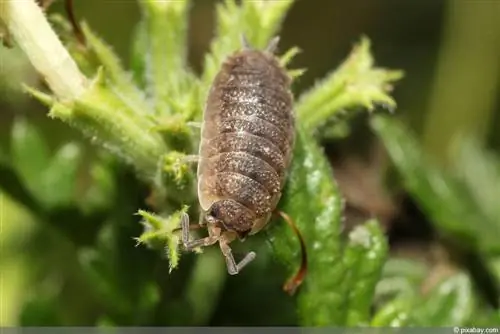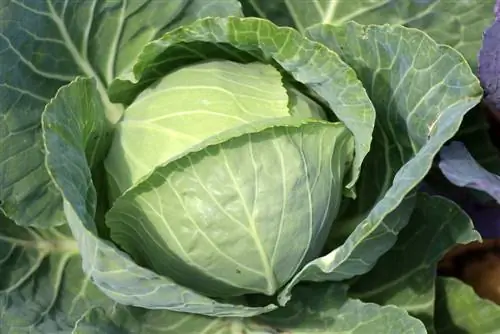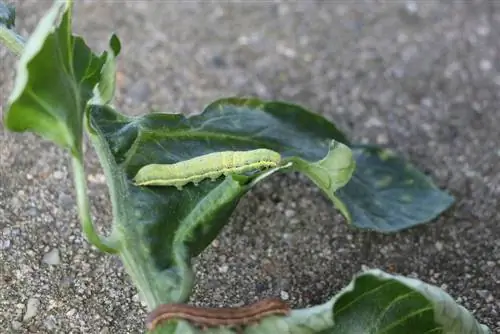- Author admin [email protected].
- Public 2023-12-17 03:39.
- Last modified 2025-01-24 12:45.
The cabbage white butterfly is one of the most widespread butterflies and a vegetable pest that should not be underestimated. Almost all cabbage species serve as host plants for their caterpillars. Here they can cause major damage in a very short space of time. This in turn can result in enormous crop losses. This makes it all the more important to start combating it at the first signs and to prevent further infestation.
Identify cabbage white butterfly
Damage caused by the cabbage white butterfly from the white butterfly family can occur from May to August. The whitish-yellow, large cabbage white butterfly (Pieris brassicae) lays its eggs in clutches of up to 20. The caterpillars that emerge are up to five centimeters long and have yellow-green and black spots. In contrast, the slightly yellower, small cabbage white butterfly (Pieris rapae) lays its eggs individually. Its caterpillars are light green and about 3.5 cm long. The best protection against this pest is bowing. If it is already too late for that, you should take action at the latest when the white butterflies are buzzing through the garden, because then it usually won't be long before the cabbage plants are swarming with caterpillars and the first damage caused by feeding becomes visible.
Damaging images in the event of an infestation
The large cabbage white butterfly lays its eggs on the undersides of the leaves of cruciferous wild plants, which the caterpillars then feed on for 3-4 weeks before they finally pupate. Of particular importance are the second generation butterflies, which lay their eggs under the leaves of cabbage plants or nasturtiums and cause the typical feeding damage there. In contrast, the range of host plants for the small cabbage white butterfly is much larger. In addition to cabbage plants and other cruciferous vegetables, these also include capers, nasturtiums and foxtail plants. The caterpillars of the small cabbage white butterfly do not just limit themselves to the leaves, but also eat their way into the hearts of the cabbage plants. The greatest damage usually occurs in July. If it is too late for preventive measures, you should definitely start fighting as early as possible, i.e. at the first signs of an infestation.
Home remedies to combat it
Fighting with home remedies can be particularly successful if the caterpillars of this pest have not yet eaten their way into the interior of the plants. If so, affected vegetable plants can usually only be disposed of.
Collect
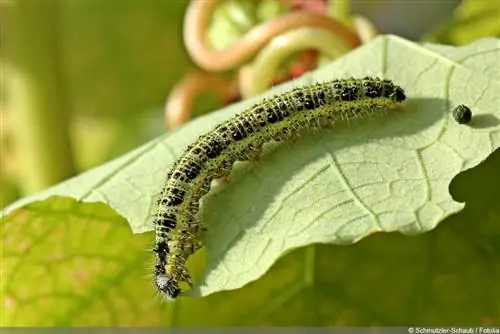
The easiest method is certainly to collect the caterpillars. However, this only makes sense in the event of an initial infestation or isolated occurrence of pests and before the cabbage hearts have formed. The longer you let the caterpillars do their thing, the greater the damage caused by feeding. From around June/July you should look for the eggs of this butterfly, which are usually laid under the leaves, and then continuously for the hatched caterpillars. The eggs are easy to crush with your fingers. With gloves on the whole thing isn't quite as unpleasant. Or you can brush them off with a hand brush and dustpan.
Tip:
If collecting with your hands is too time-consuming or disgusting, you can borrow a special vacuum cleaner for such activities. Occasionally they are offered on loan in well-stocked garden centers.
Tobacco ash and stone dust
If it is not enough to collect the caterpillars, you can try to drive them away or keep them away with tobacco ash or stone dust. To do this, first moisten the plants with a watering can or garden hose so that the ash sticks to them. Then you dust them with tobacco ash. As an alternative to tobacco ash, you can also spread a very thin layer of stone dust over the plants.
Tip:
You should avoid oily products if possible, as they can do more harm than good to the plants.
Plant broths made from tansy and wormwood
Another, very gentle way to combat the cabbage white butterfly and its caterpillars is to use plant broths made from tansy and wormwood. The intensive odors of both plants as well as the bitter substances of the tansy are particularly effective against the cabbage white butterfly.
- Flowers, leaves and stems are used
- Best time to collect is from July to August
- Suitable for making broth, fresh and dried herbs
- You need 300-500 g fresh or 30 g dried herb and 10 liters of water
- First soak the herb in water for about 24 hours
- Preferably use rainwater
- Then cook the whole thing for about 20-30 minutes
- Bitter substances and essential oils can be released from the plants
- Then let the mixture cool down
- After cooling, pour through a sieve
- Apply finished tansy broth during the flight period of the cabbage white butterfly
- Spray undiluted onto the soil around the plants and the root necks
Wormwood broth is sprayed directly onto the cabbage plants and the ground in June and July in a ratio of 1:3 (1 part wormwood broth, 3 parts water). If you want to grow wormwood yourself in the garden for the purpose of pest control, you should always do so in a separate, remote area of the garden due to the unfavorable influence on neighboring plants but also on earthworms and other beneficial insects. For the same reason, wormwood should not be disposed of in the compost.
Tip:
Stinging nettle broth is good for many things, but is generally counterproductive against the cabbage white butterfly because it attracts butterflies, including the cabbage white butterfly.
Cold water extracts from tomato leaves
A cold water extract made from the shoots (barren side shoots) of tomatoes can be used to combat the cabbage white butterfly or to drive it away. Here too, the effect is based on the strong smell, which is intended to confuse or deter the pests.
- Make cold water extract from fresh plant material
- Soak about 1 kg of fresh tomato leaves or shoots in 10 liters of water
- Let the whole thing stand for 1-2 days
- Then strain and store in sealable containers
- Mixture should under no circumstances ferment
- Use the finished, undiluted brew shortly before and during the flight time
- Spray plants preferably when the weather is overcast

As an alternative to a cold water extract from tomato leaves, you can simply spread tomato leaves and/or shoots on the ground under the cabbage plants. However, new ones have to be added at regular intervals. The dried plant parts can safely remain on the ground and serve as mulch and a source of nutrients.
Natural predators
Like most pests, the cabbage white butterfly also has natural predators that can be used to combat both the butterfly itself and its caterpillars. In addition to birds, there is a certain species of parasitic wasp, the so-called cabbage parasitic wasp.
- Cabbage parasitic wasp is actually a brackish wasp (Cotesia glomerata)
- Brackish wasps are only 0.3 cm tall
- The first three larval instars parasitize various butterfly caterpillars
- Including that of the great cabbage white butterfly
- Female brackish wasps lay up to 150 eggs per caterpillar
- Development of the larvae takes place inside the caterpillars of the cabbage white butterfly
- Break through the skin of their host caterpillars shortly before pupation
- This kills the caterpillars of the cabbage white butterfly
In addition to using brackish wasps, you can use an insect hotel to attract other useful insects to your home garden and thus protect not only cabbage plants but also many other useful and ornamental plants from pests. In addition to supporting pest control, an insect hotel can attract important helpers for pollinating vegetable, fruit and berry trees. In addition, it makes sense to create appropriate shelter options for other predators such as predatory beetles and ground beetles. These beetles like to use hiding places such as piles of stones, leaves and dead wood, tree stumps, moist areas under ground cover plants or with moss.
Tip:
Shrews, moles, hedgehogs and chickens also like to eat the caterpillars of the cabbage white butterfly.
Effective prevention
The best protection against the cabbage white butterfly and especially its voracious caterpillars is prevention. The main aim is to prevent the butterflies from laying eggs. The best way to implement this is with cultural protection networks and coordinated mixed cultures.
Culture protection networks
Culture protection nets or corresponding fleeces offer simple, cost-effective and effective protection against a variety of pests, such as:B. the vegetable fly, the cabbage fly, the Colorado potato beetle, the gall midge and various harmful butterflies such as the large and small cabbage white butterfly. They also offer protection against bird damage.
- Nets used should be fine-meshed (maximum 2 mm) and intact
- Should be applied early or stretched over vegetable beds
- Early means immediately after sowing or planting
- Time for application around April
- Be sure to avoid loopholes for pests
- Dig the edges of the net into the ground all around
- Additionally weigh it down with stones
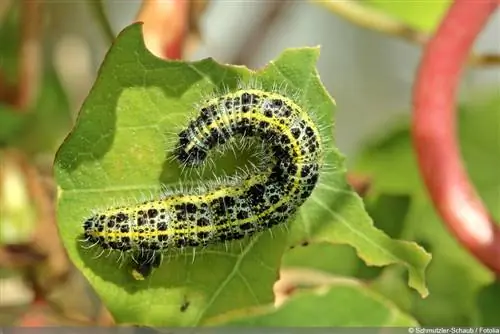
Furthermore, the nets should remain on the beds throughout the entire cultivation period and care should be taken to ensure there is sufficient volume, because the cabbage plants grow tall. If very close-meshed nets or even fleece are used, they should be opened and ventilated regularly, especially in summer when the heat is high, to prevent the vegetable plants from overheating. In order to increase the effectiveness of these nets, crop rotation should be observed and mixed crops should be grown at the same time.
Tip:
Even if cultural protection nets can keep the cabbage white butterfly away relatively well, they are not a panacea against this or other pests. Regular checking of the plants is still essential.
Observe crop rotation
Complying with crop rotation is the basis for he althy, pest-free vegetables and a bountiful harvest. Adhering to crop rotation means not growing the same vegetables in the same location year after year. Otherwise, this increases the risk of pest infestation. Cruciferous vegetables such as cauliflower, kale and kohlrabi should only be grown on the same bed again after four years at the earliest. This also applies to green manure with cruciferous vegetables, which should also be avoided. Good previous crops for cabbage include beans, peas, sweet corn, celery and rye. Cabbage itself is a rather poor previous crop.
Growing mixed crops
There are many good reasons for mixed crops. One of them is protection against the cabbage white butterfly or at least a reduction in infestation. Mixed cultures with strong-smelling plants are particularly recommended to protect against this harmful butterfly and its caterpillars. These include celery, tomatoes, onions, elderberry, broad beans, leeks, borage, lettuce, spinach, marigold, privet, nasturtium as well as chamomile, basil, coriander, tansy, mugwort, rosemary, sage and thyme. The natural defense of these plants against the cabbage white butterfly is based on the mustard oils they contain.
Tip:
In addition to crop rotation and mixed culture, fertilization should not be carried out too much and, above all, with too much nitrogen. The all-rounder nettle manure is completely unsuitable as a fertilizer here because it attracts this pest.

